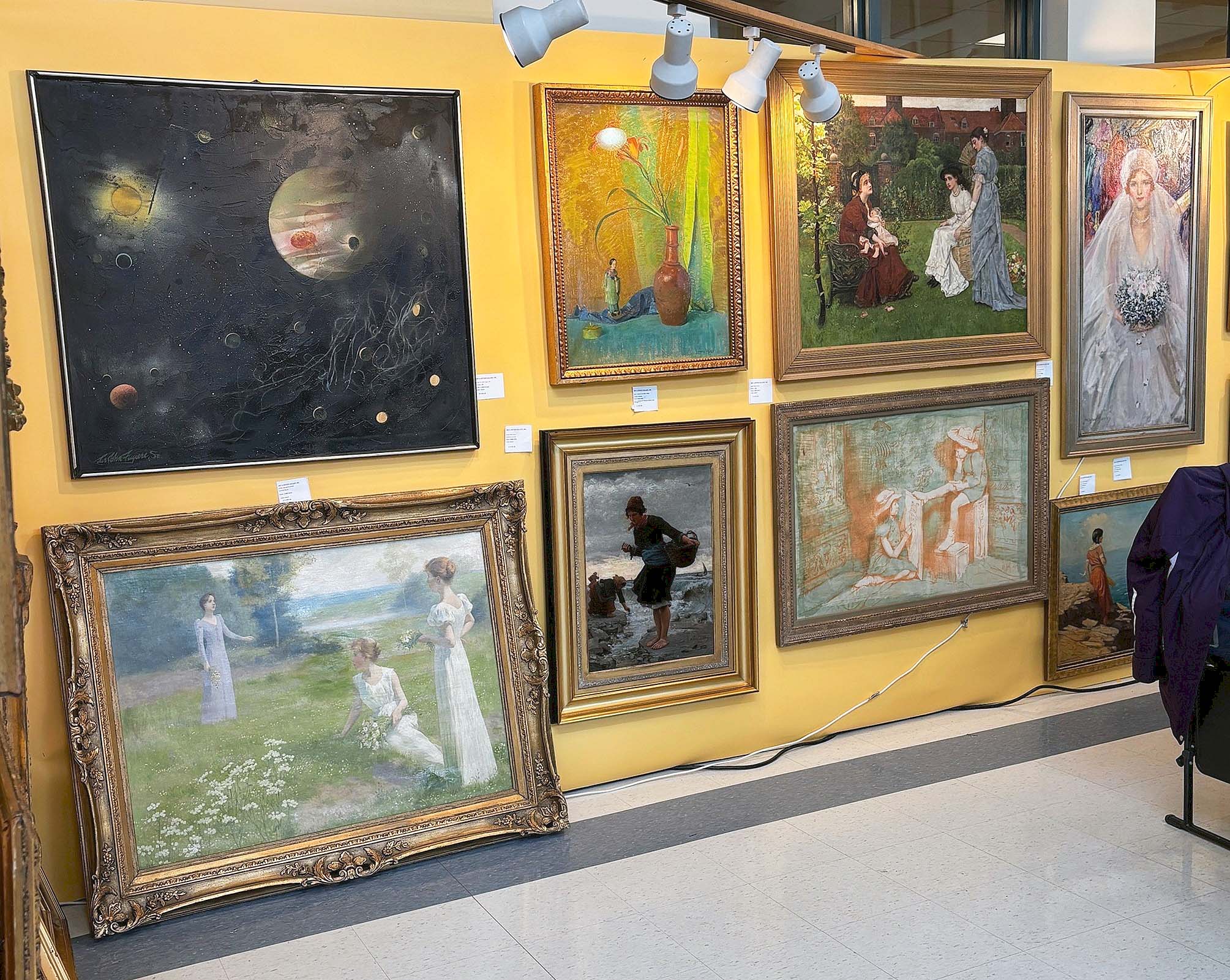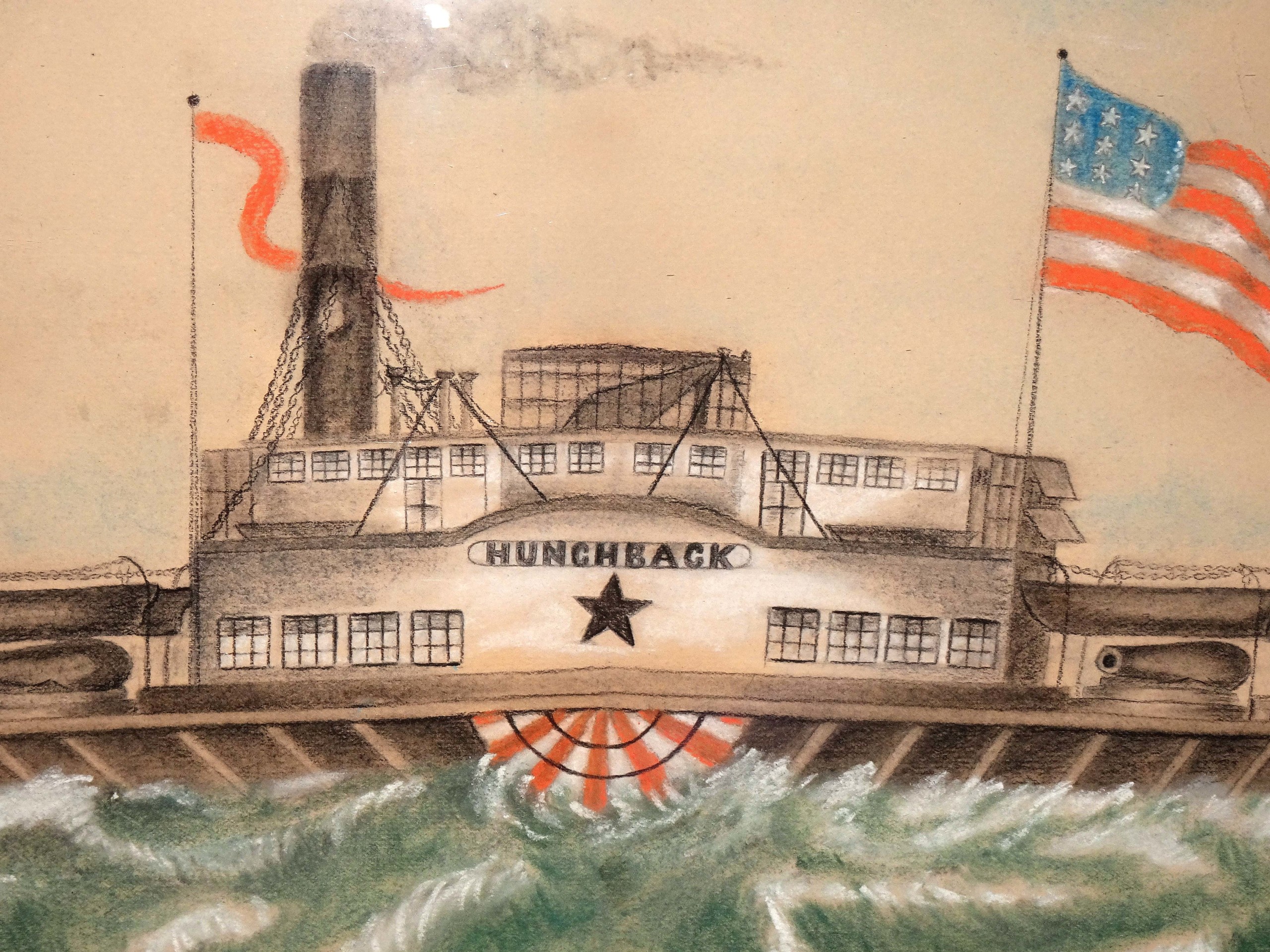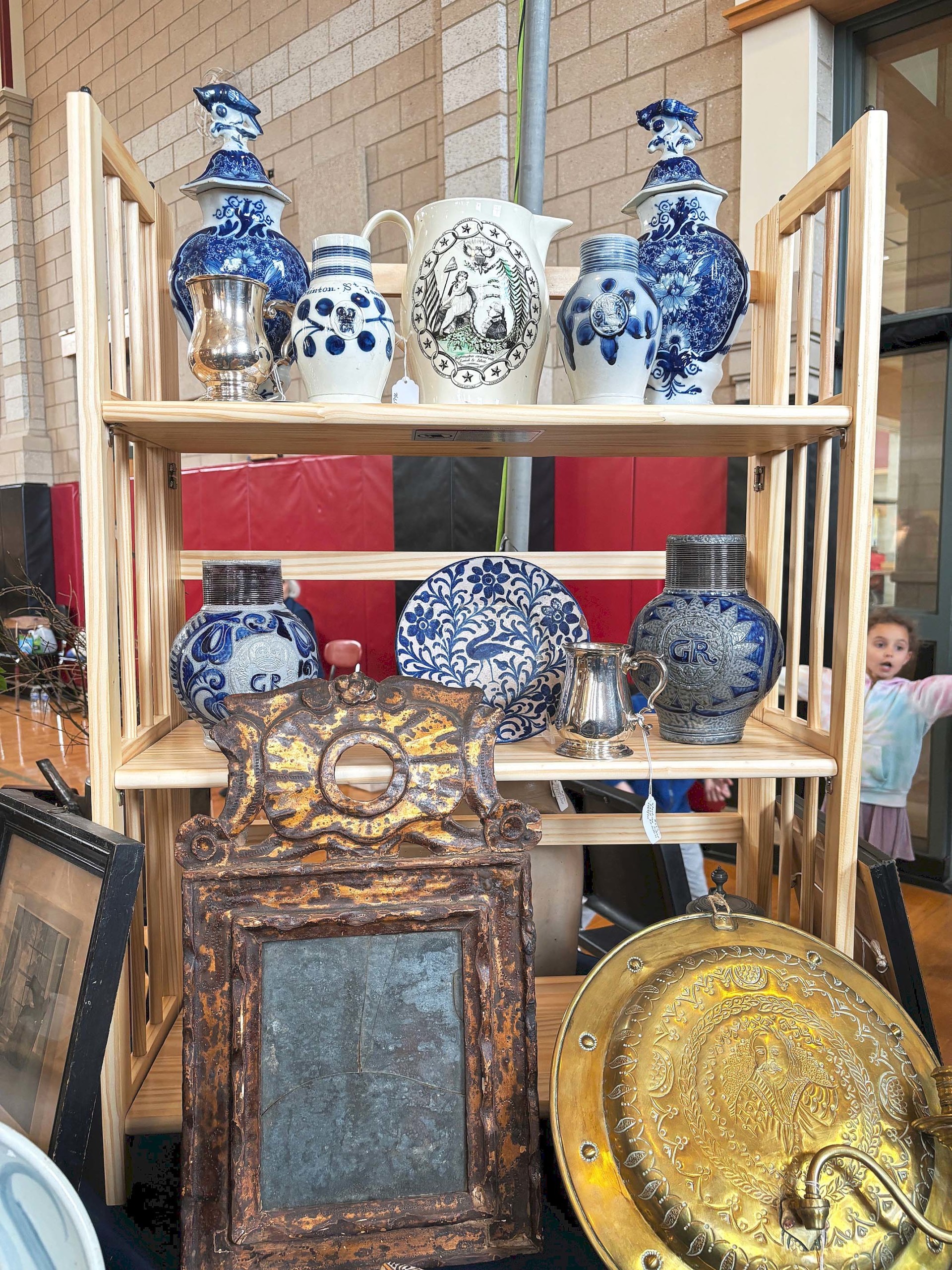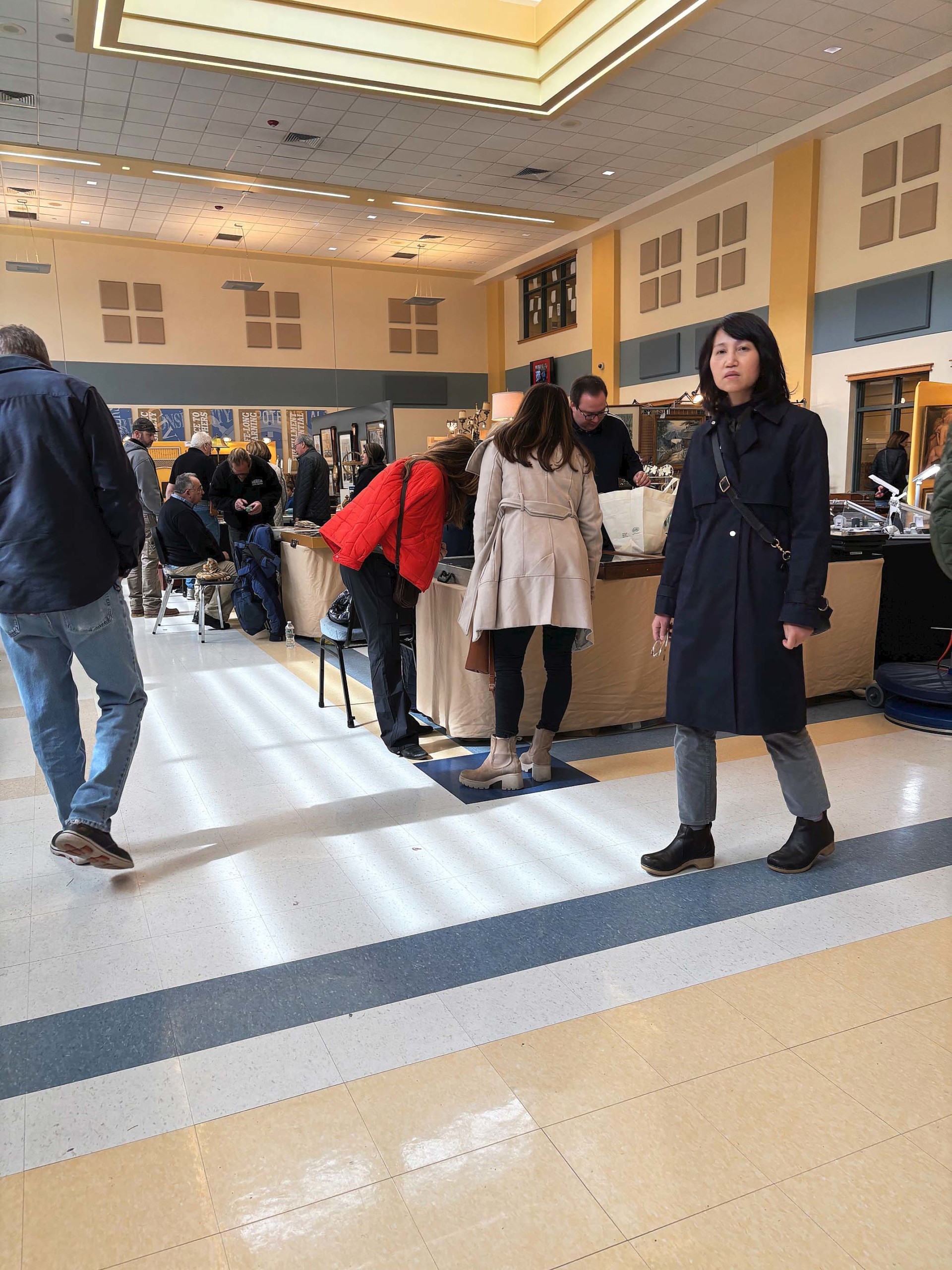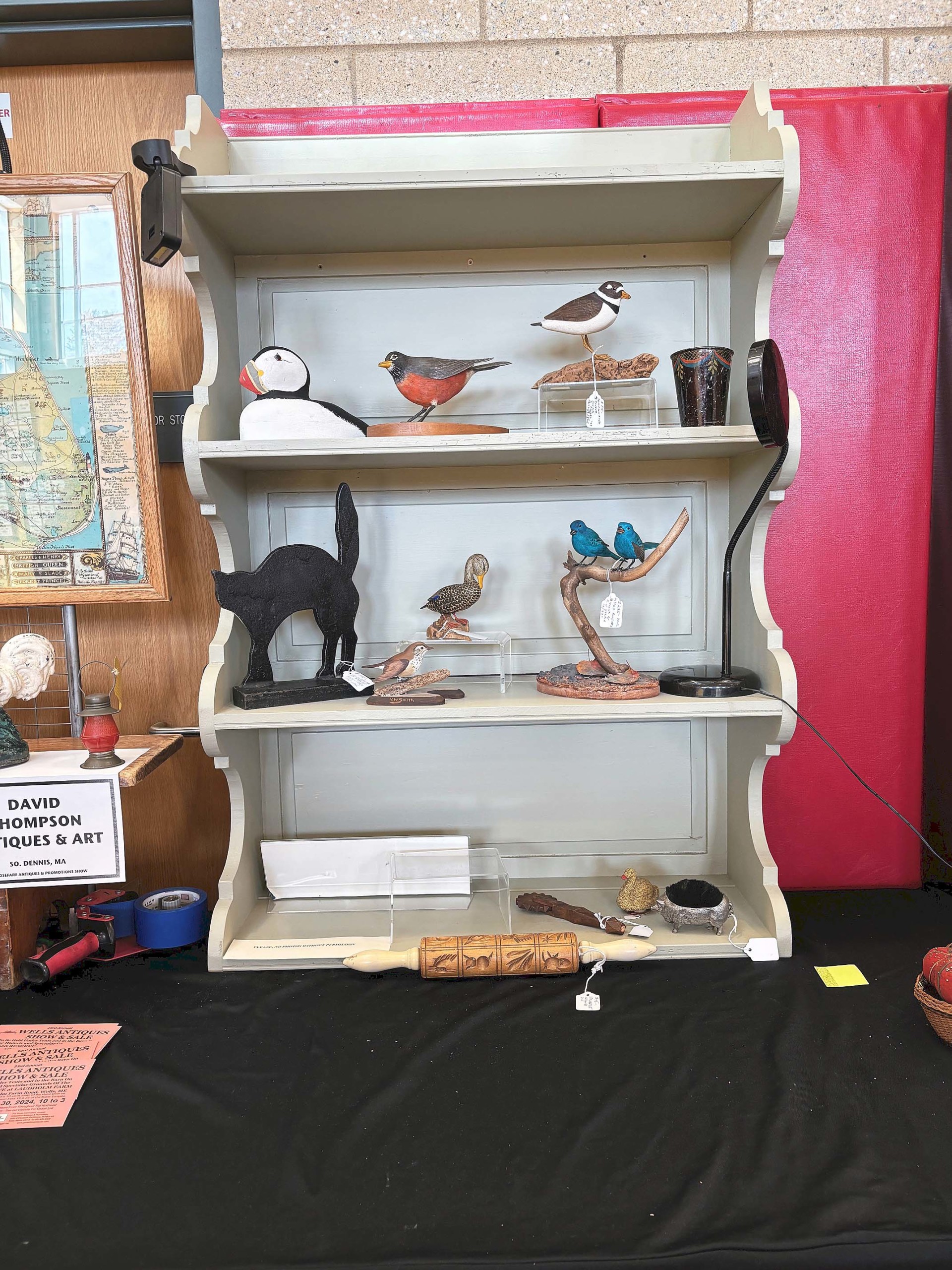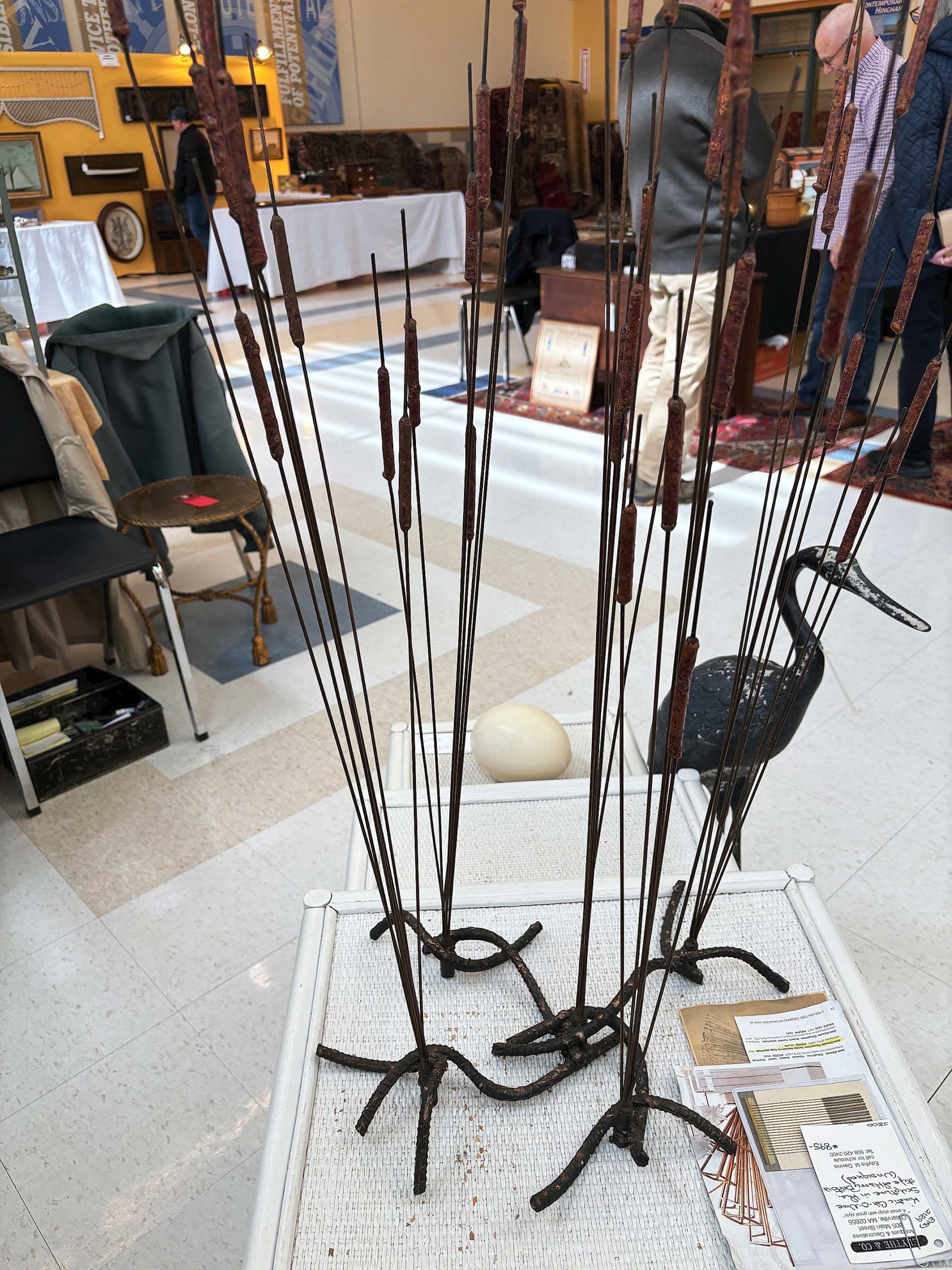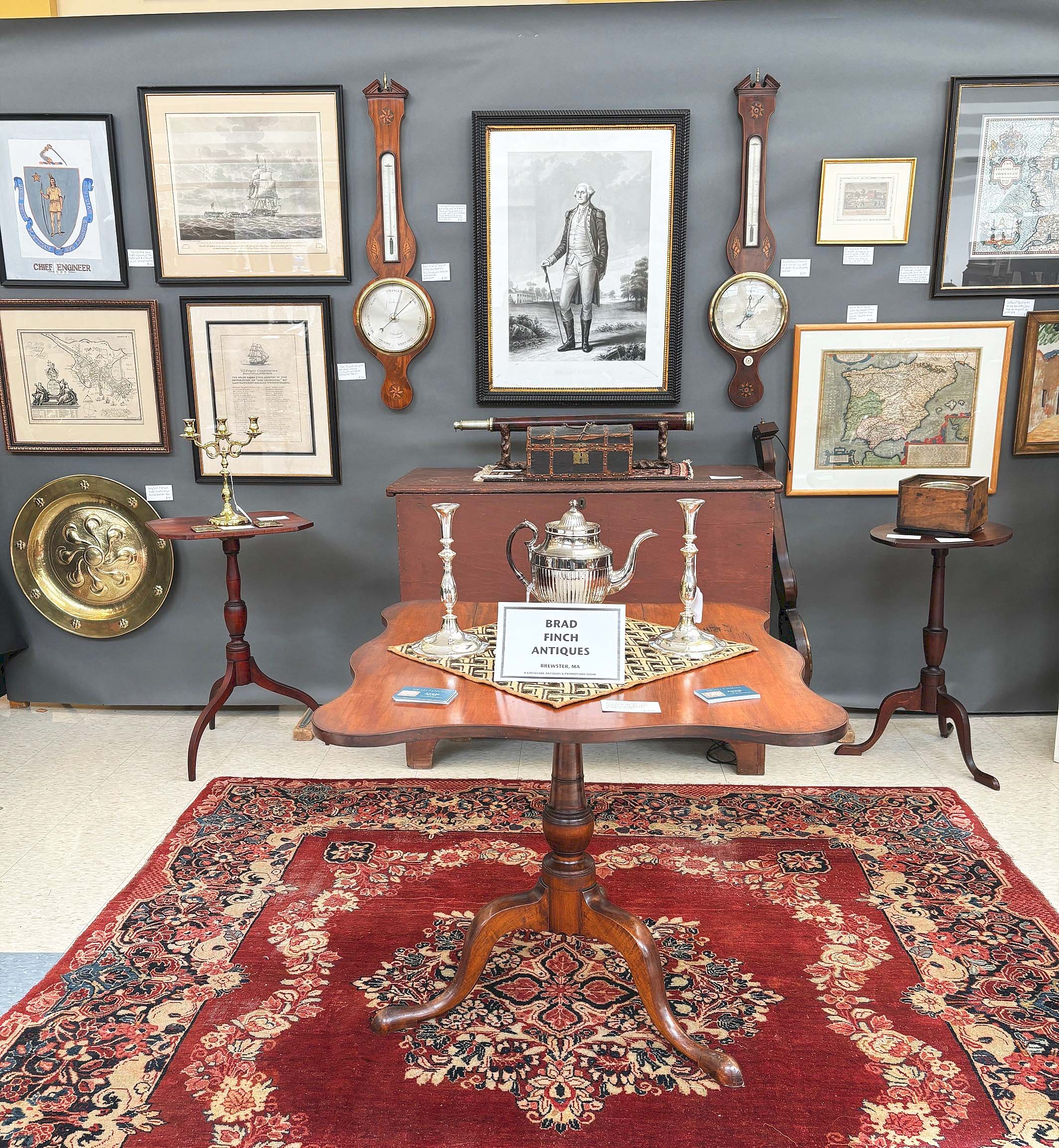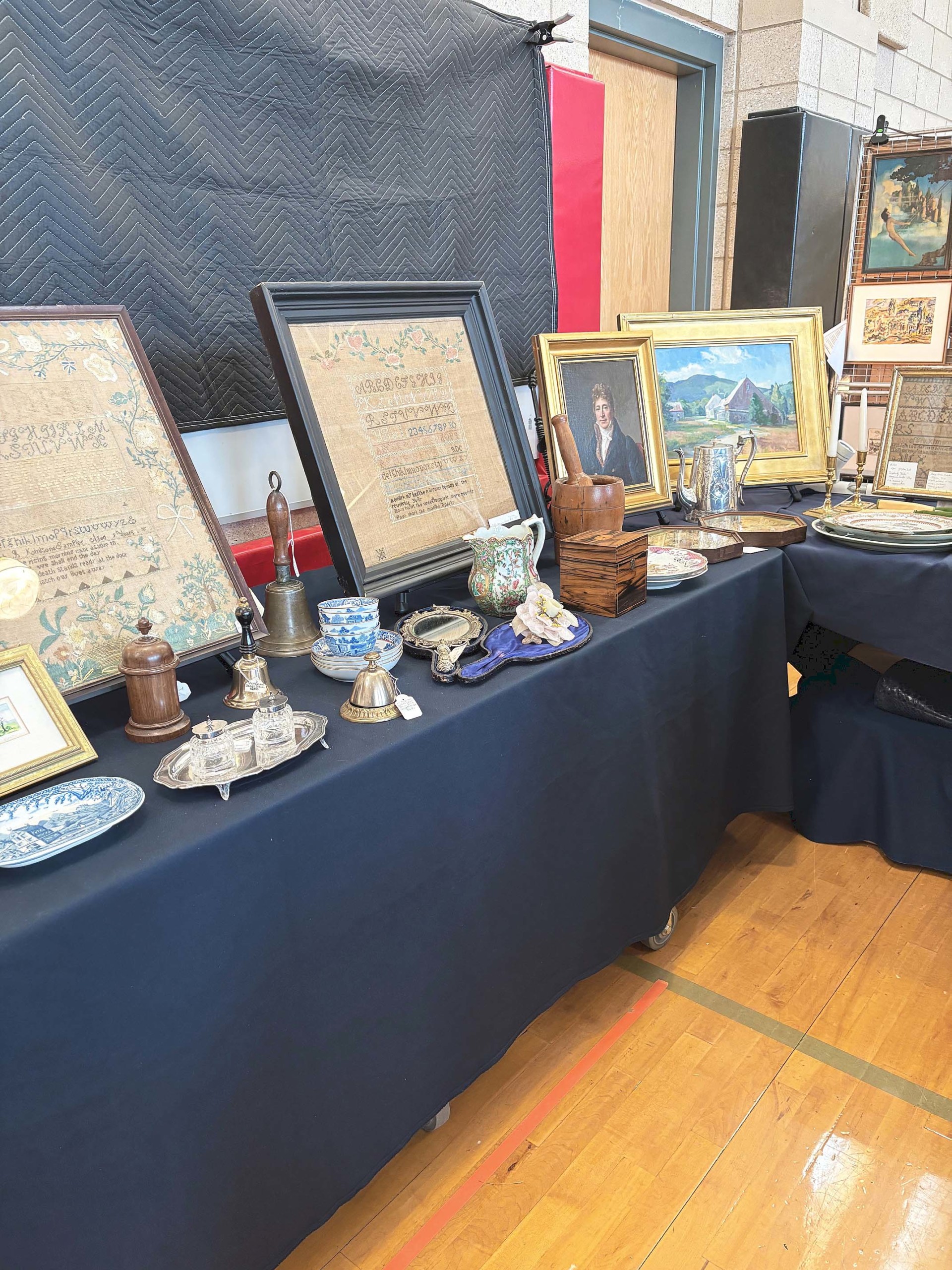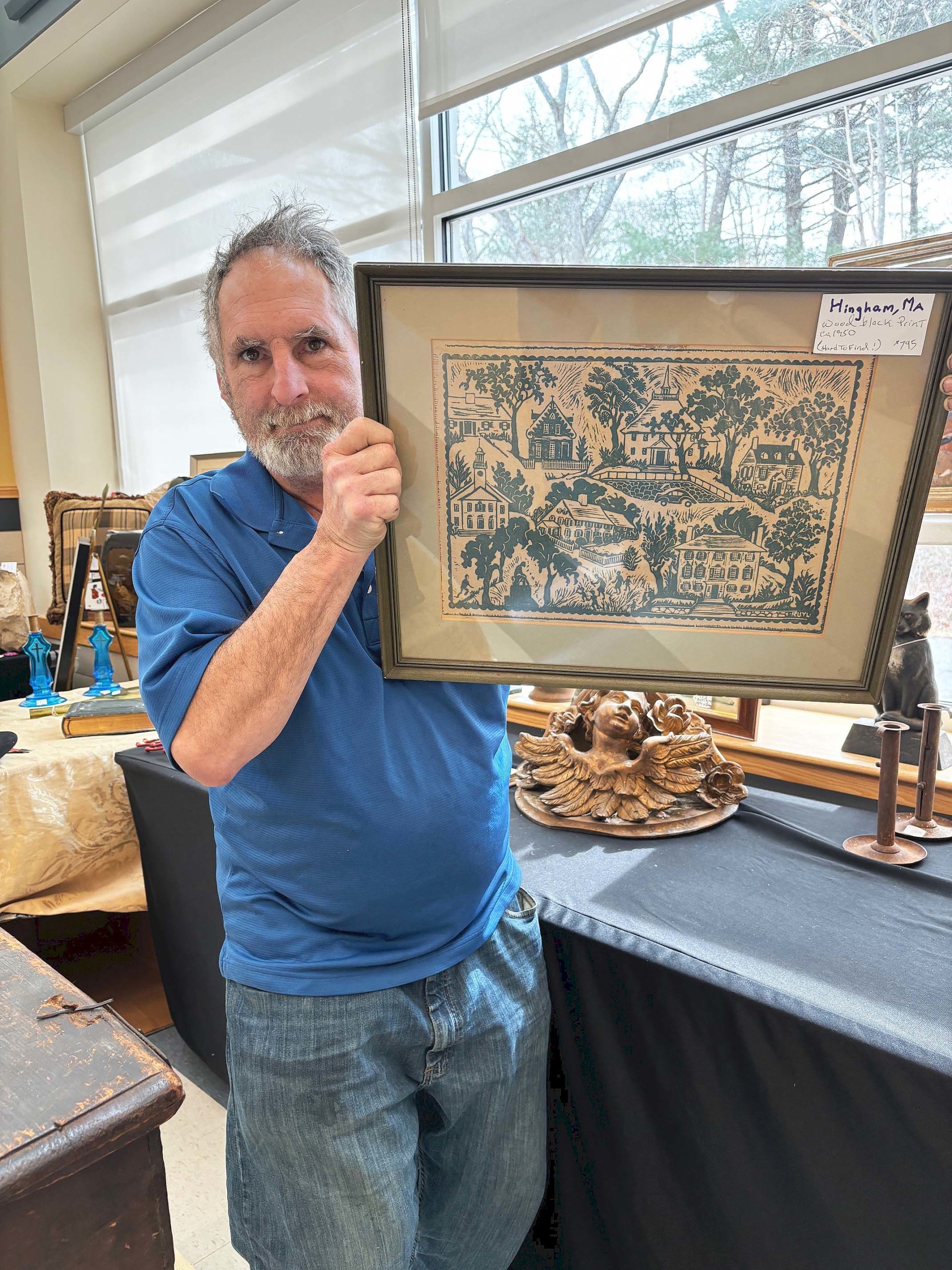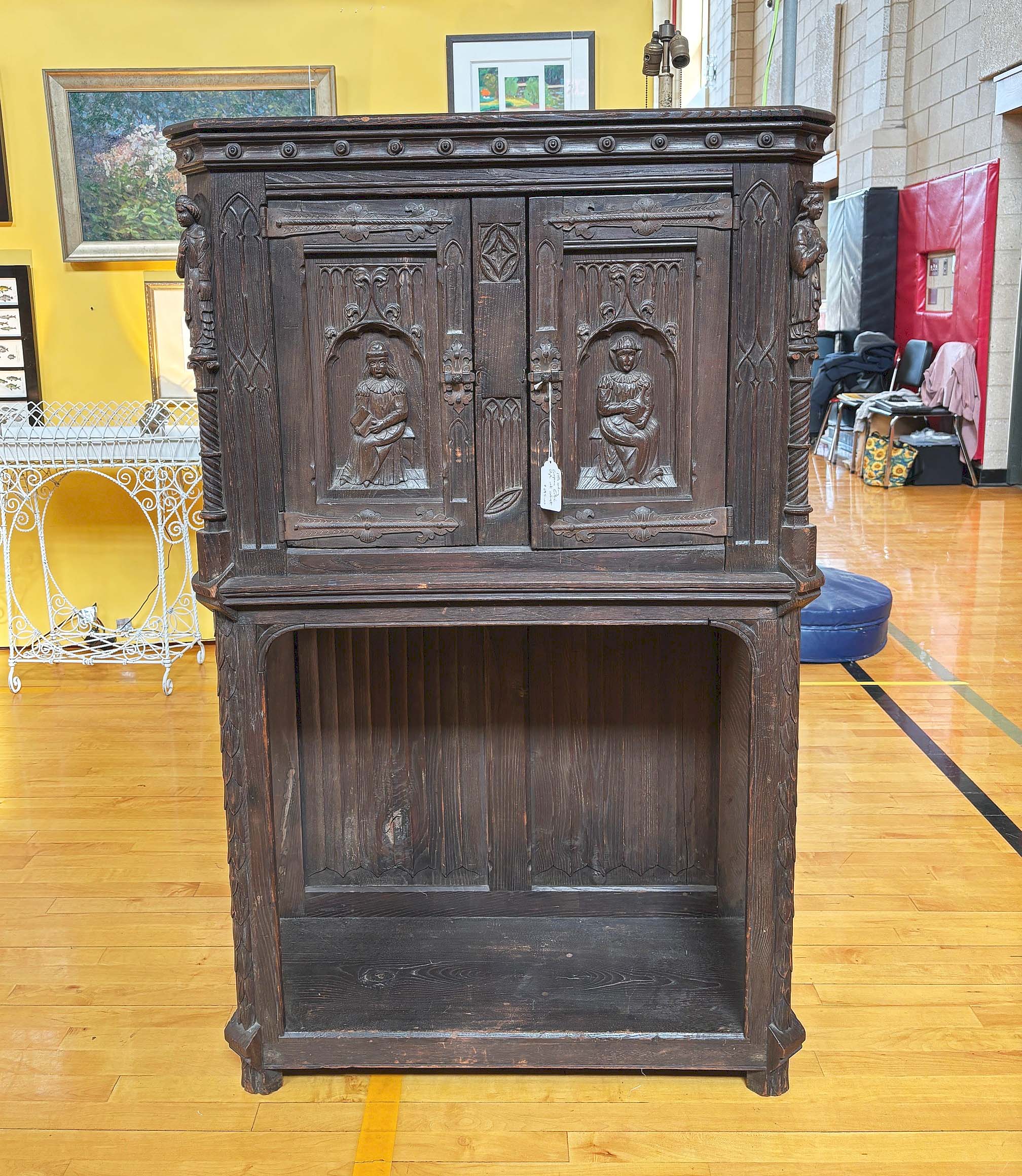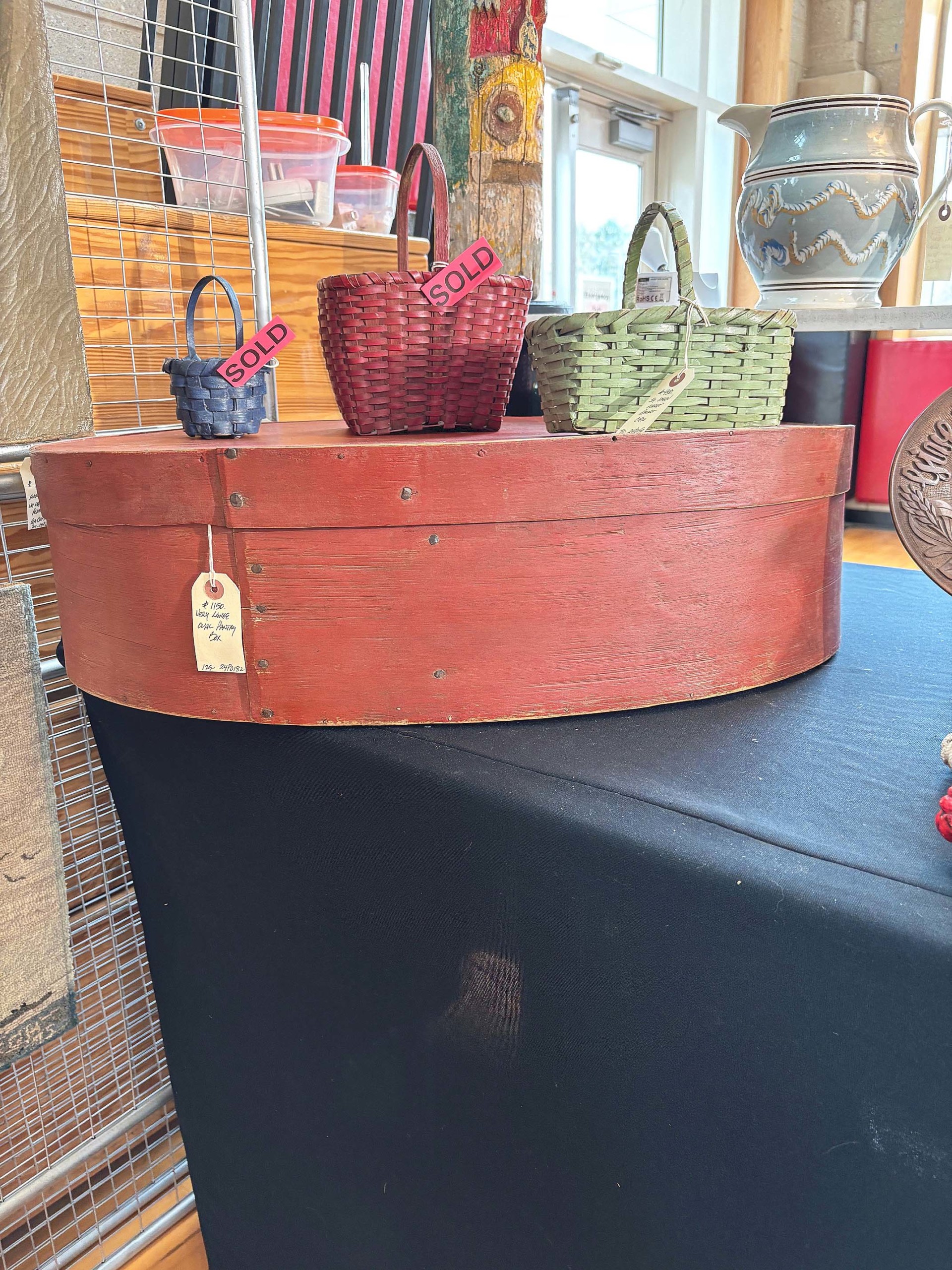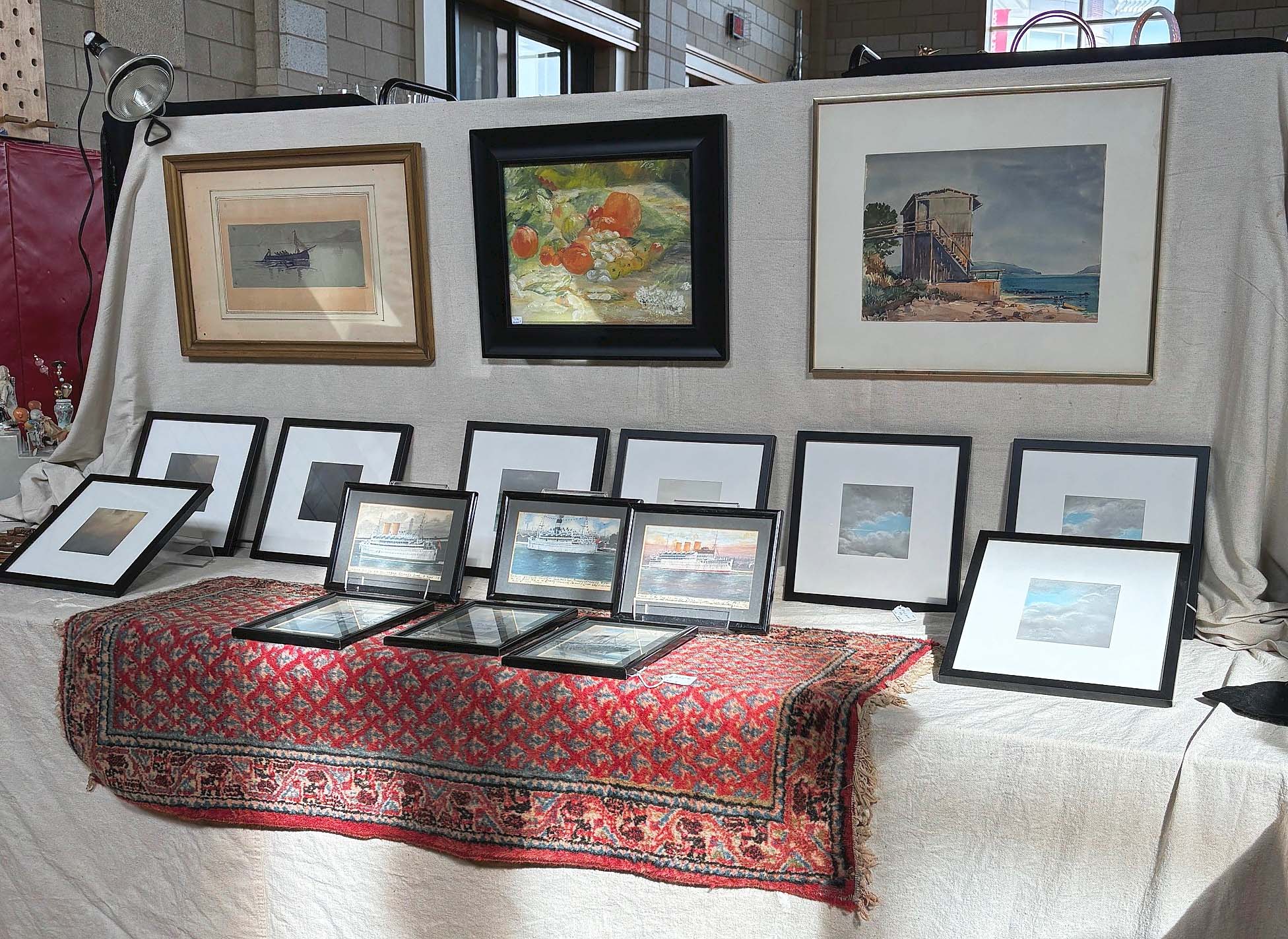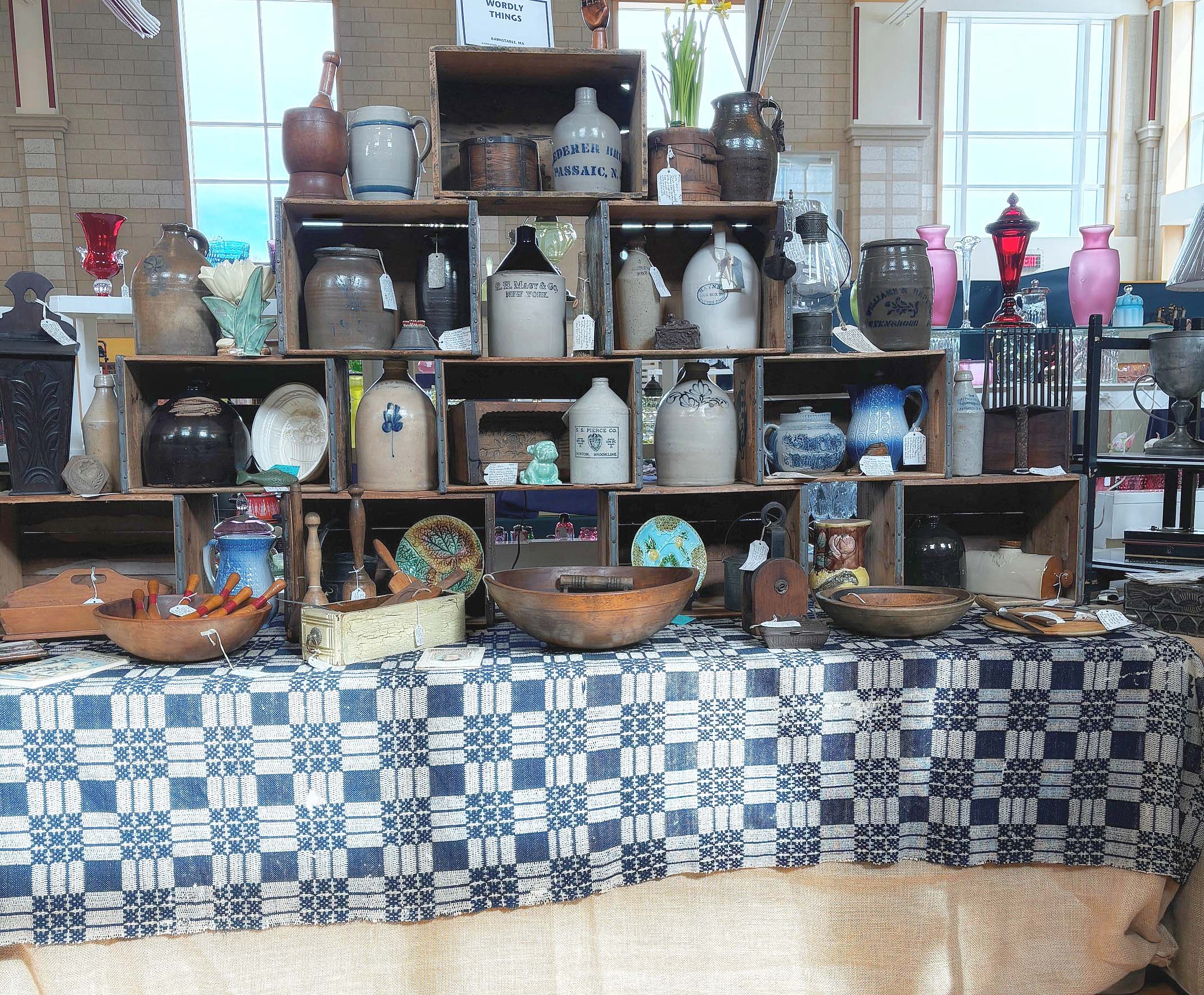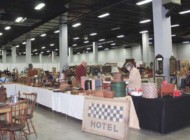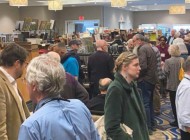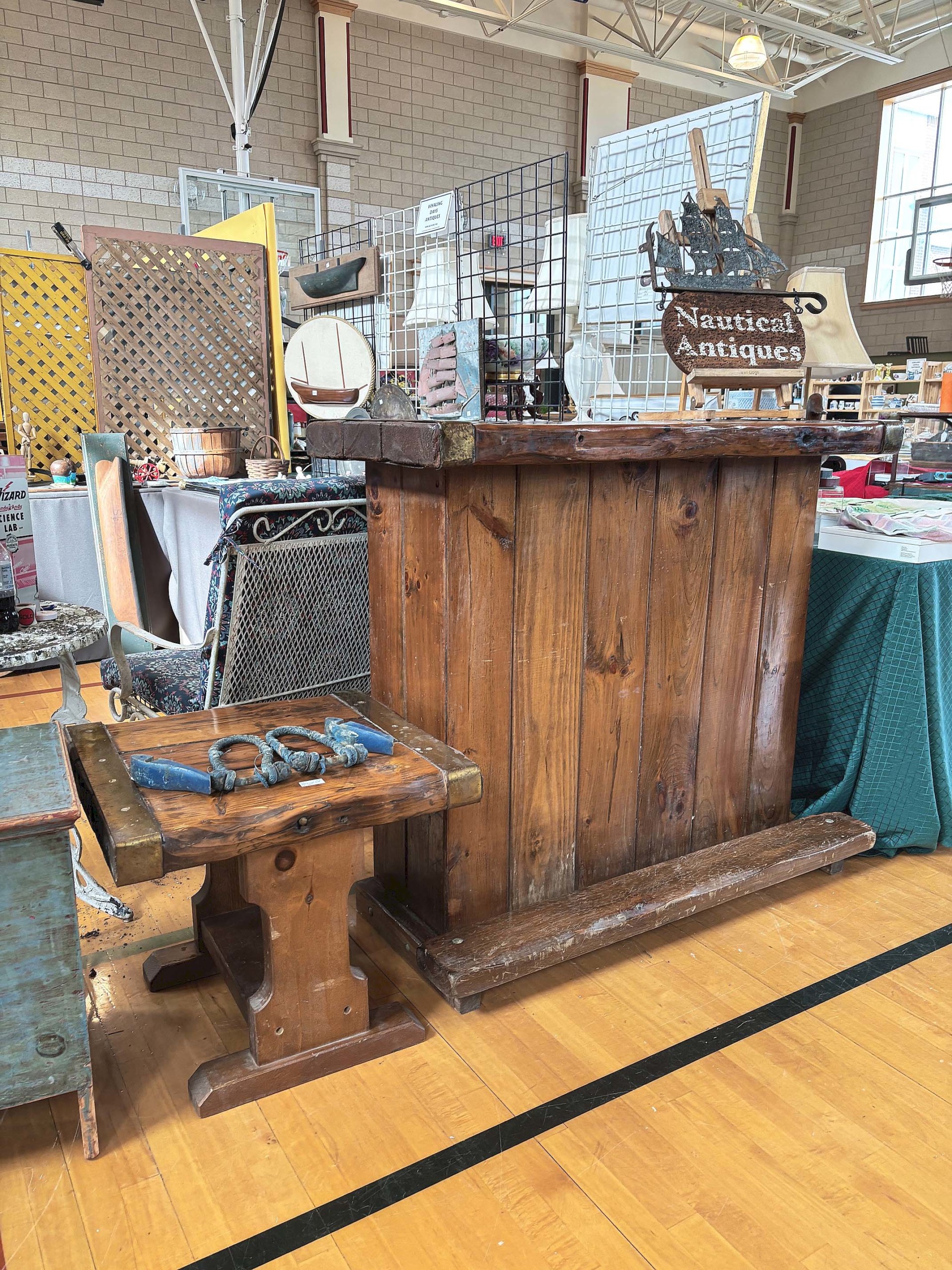
Hatch covers from World War II cargo ships are sometimes repurposed as furniture. Whaling Days Antiques, New Bedford, Mass., had ones that had been made into a bar and an end table. They were asking $250 and $85, respectively.
Review & Photos by Rick Russack
HINGHAM, MASS. — The 35th Hingham Antiques Show, held on March 23-24, has been a staple on the antiques calendar for Massachusetts’ South Shore for 35 years. With about 45 exhibitors, it uses the gymnasium and cafeteria of the large Hingham Middle School, which is well known to local residents and easy to find for first-time visitors. What happens when a show offers quality merchandise and reasonable prices? Easy answer: everyone has a good time and exhibitors sell well.
Successful dealers acknowledge that customers are cost-conscious – a reality that guides their pricing strategy. John DeSimone, Goosefare Antiques, who sold three pieces of furniture, was one of the dealers who said their intent when pricing was to price as reasonably as they could. Bruce Emond, Village Braider Antiques, said that he also prices as conservatively as he can. It works for him as he can almost always point to multiple sales at any given show, including this one.
Bob Markowitz, another dealer with numerous sales, commented that he’d rather price on the low side and make the sale, rather than over-price an item. An indication that buyers are aware of these pricing philosophies is that certain booths are “destinations” for shoppers, and their booths quickly draw buyers when shows open. Greg Hamilton, Stone Block Antiques, falls into this category.
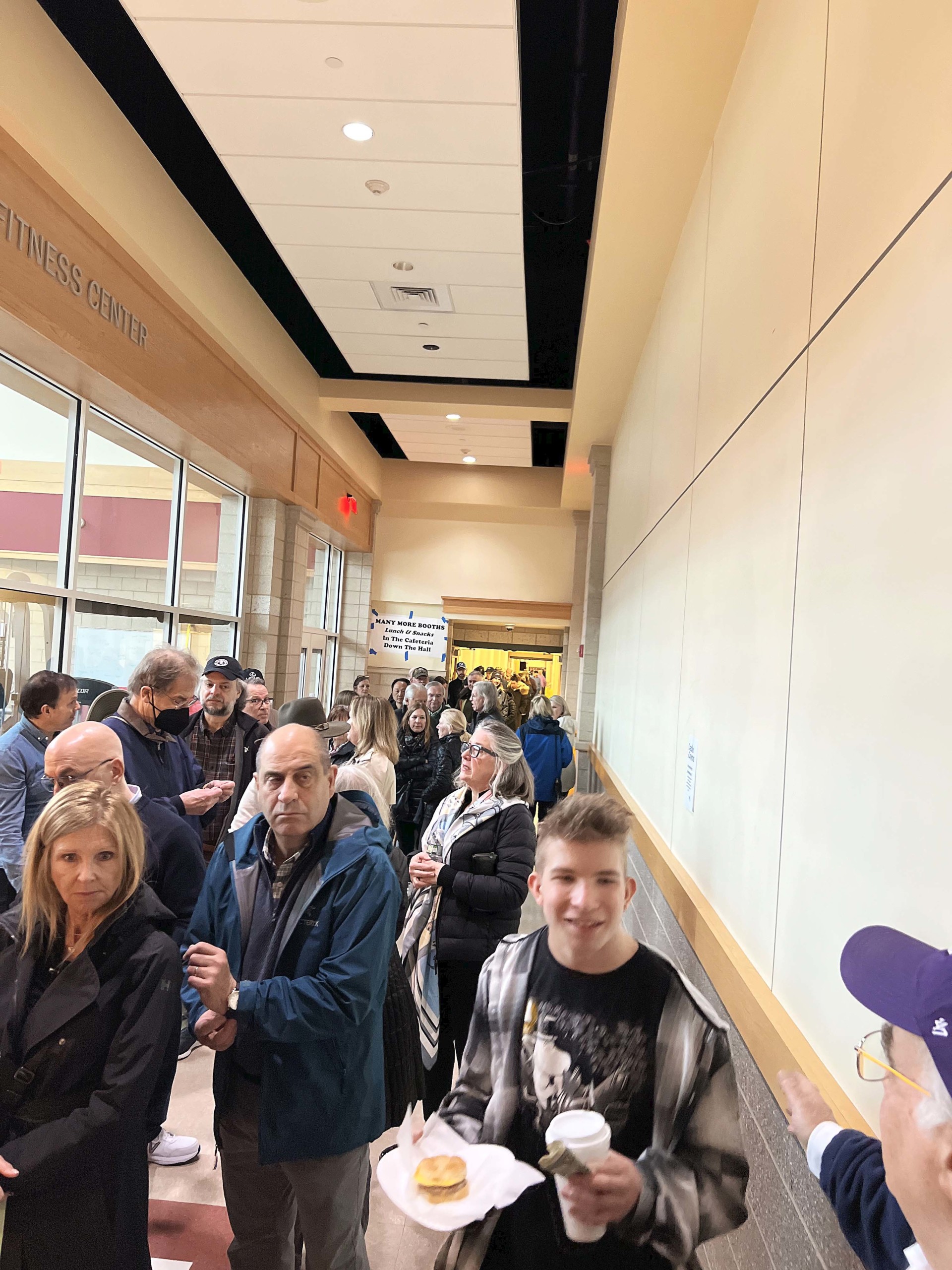
A long hallway was filled with shoppers waiting for the show to open Saturday morning; there were more showgoers in another area. Photo courtesy Goosefare Antiques and Promotions.
Nearly every exhibitor we spoke with said they had a “good,” if not “excellent” show. It probably did not hurt that the weather on opening day was one of those raw, New England winter days that, not being conducive for outdoor activities, was good weather for antiquing.
Most of the exhibitors have done this show before and know what customers are looking for. Emond said he sold four pieces of furniture the first day. John and Liz DeSimone, Goosefare Antiques, Wells, Maine, sold two pieces of furniture and John was out delivering one when we spoke on the phone. Oliver Garland, Falmouth, Mass., said that he had sold one fairly expensive item and that he made several sales of lesser valued items as well. David Weidner, Dark Flowers Antiques, Fall River, Mass., said the first day “was an excellent day.” Similar comments were made by several dealers and all said there had been a good crowd.
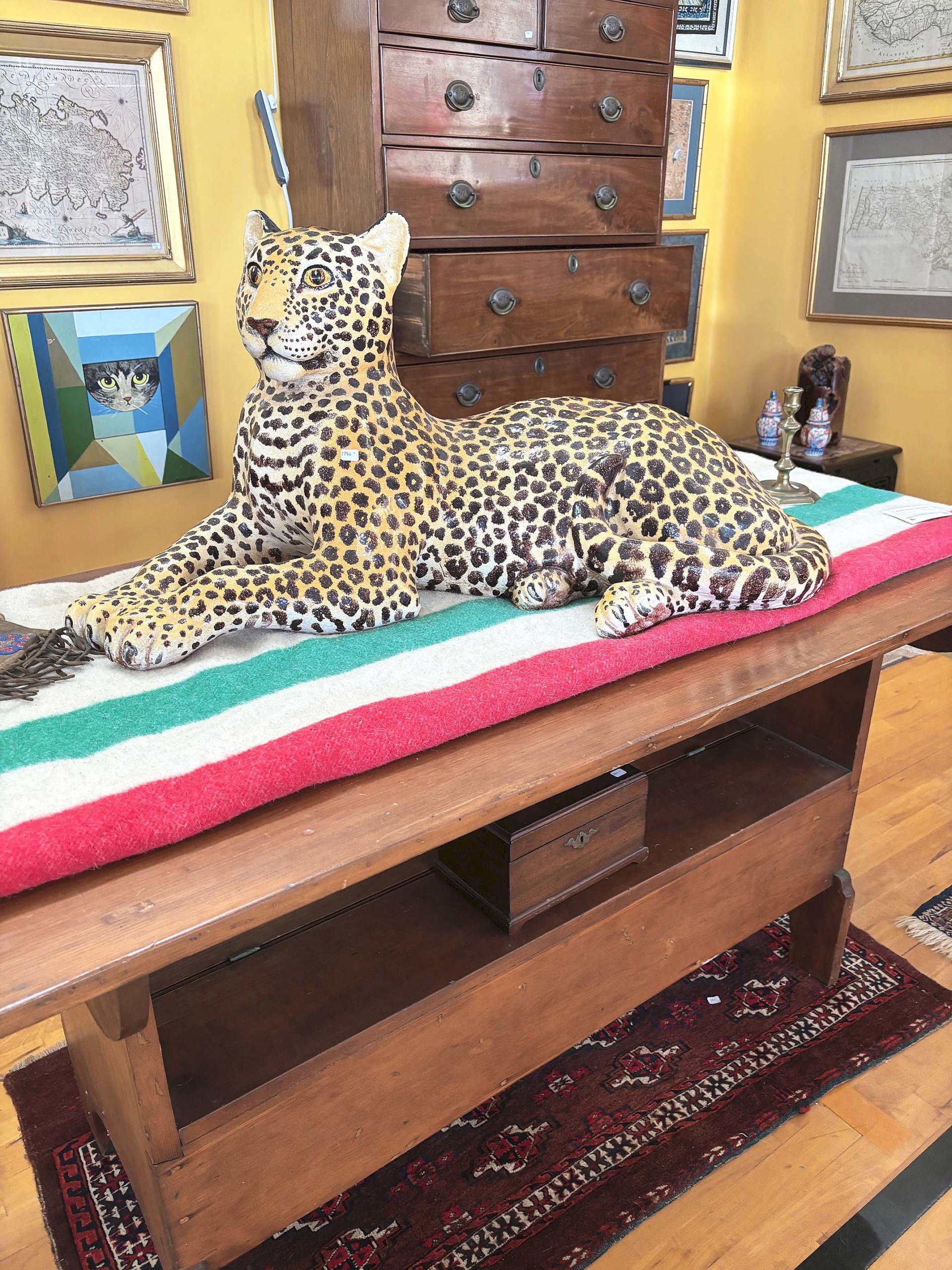
You couldn’t miss this large circa 1960 Italian leopard when you walked into the show. Greg Hamilton, Stone Block Antiques, Vergennes, Vt., was asking $1,750 for it.
Upon entering the show, the first booth you would have encountered belonged to Greg Hamilton, Stone Block Antiques, Vergennes, Vt. Hamilton sources nearly all his merchandise from Vermont homes, which in this instance means two things: one is that you never know what you’ll find in his booth and it’s likely the merchandise is fresh to the market. You also almost never see the same thing twice at subsequent shows. Visitors probably saw a large, life-like, Italian ceramic leopard stretched out on a table. It was priced $1,750 and likely dated to the 1960s. On an adjacent wall was a 1679 map of the Sahara region, priced $450, and an early map of the state of Massachusetts he was asking $375 for. There were a number of paintings, and furniture offerings that included a japanned secretary with a fall-front desk. A likely custom-made piece dating to the Twentieth Century, it was considered to be in fine condition and was reasonably priced at $775.
Whaling Days Antiques, New Bedford, Mass., had two pieces of furniture made from salvaged iron-bound hatch covers from World War II-era ships; both were refinished. One had been made into a bar, and, with two chairs, was priced $250. The other piece was an end table listed at $85. The booth included scrimshaw and other nautical themed items, including a half-hull model marked $125.
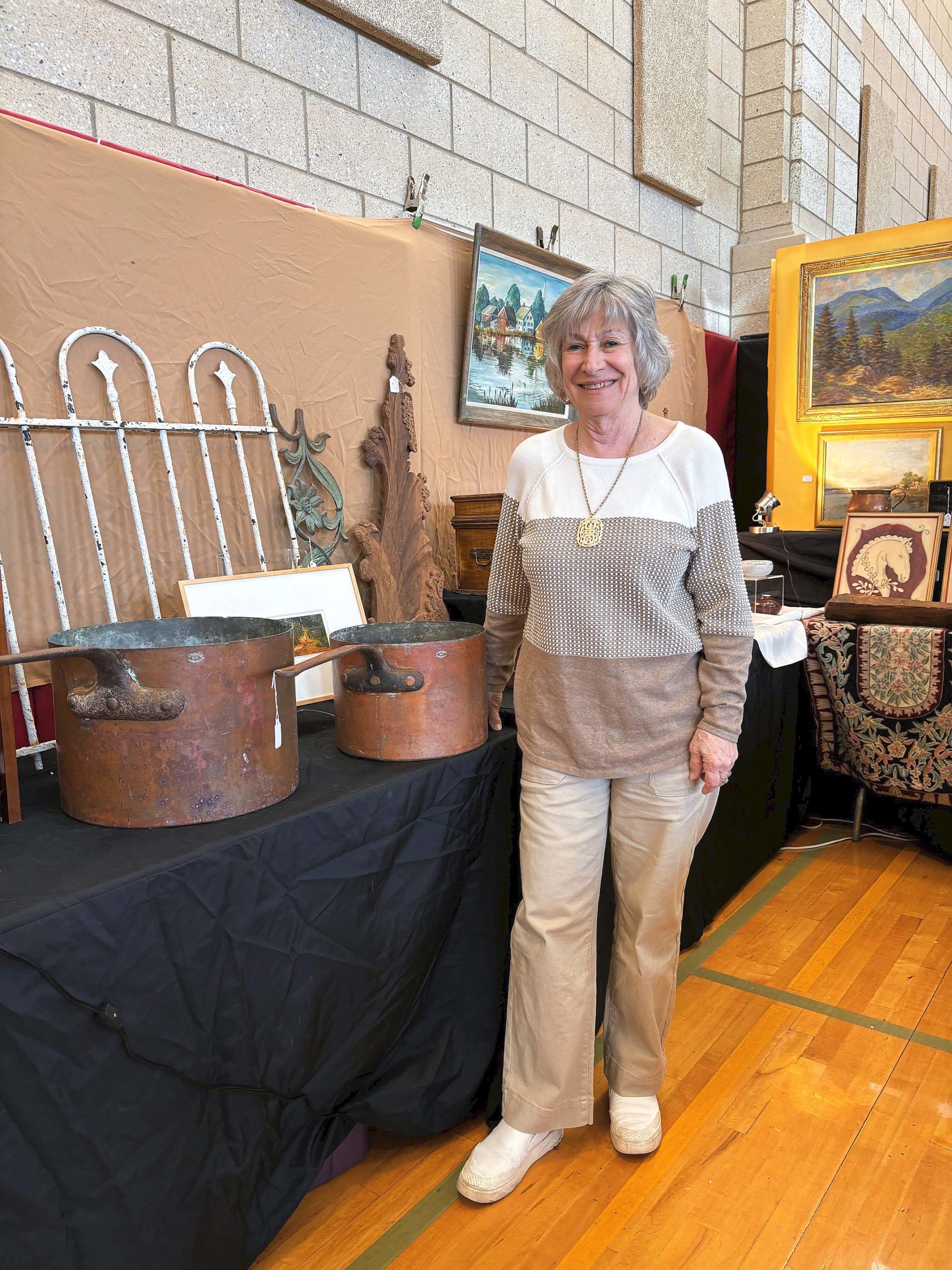
Susan Baker, Uniquities, Essex, Mass., said that she thought the two large, heavy copper pots had been used in a commercial setting, not a home. “They’re much too heavy to be used in a home kitchen.”
Sue Baker, Uniquities, Essex, Mass., said that two large, heavy copper kettles she had were quite unusual. Each had large iron handles for lifting and both were marked by a Nineteenth Century New York maker, DH&M. The larger of the two was priced $320, the smaller $220. She thought they had served a commercial purpose, perhaps candy making. She also offered a painting of Carter Notch in New Hampshire’s White Mountains. It’s an uncommon subject as Carter Notch is a high mountain pass near Jackson, N.H., but is only accessible by rugged mountain trails measuring eight miles round-trip. Baker was asking $1,250.
Bob Markowitz, Groveland, Mass., said that he sold an excellent quilt early in the show, a very good primitive painting, among several other sales. He said, “I wish I hadn’t sold that quilt — it was really a great one.” His booth had an unusual, detailed graphite drawing of a large steam locomotive. At first glance, it appeared to be a lithograph. On the back was a label which said “June 13, 1878. Time spent on this drawing was 84 hours and it was signed indistinctly ‘O.L. Sev-’”; it was priced $575. A large colored lithograph of an early steam locomotive tagged $895.
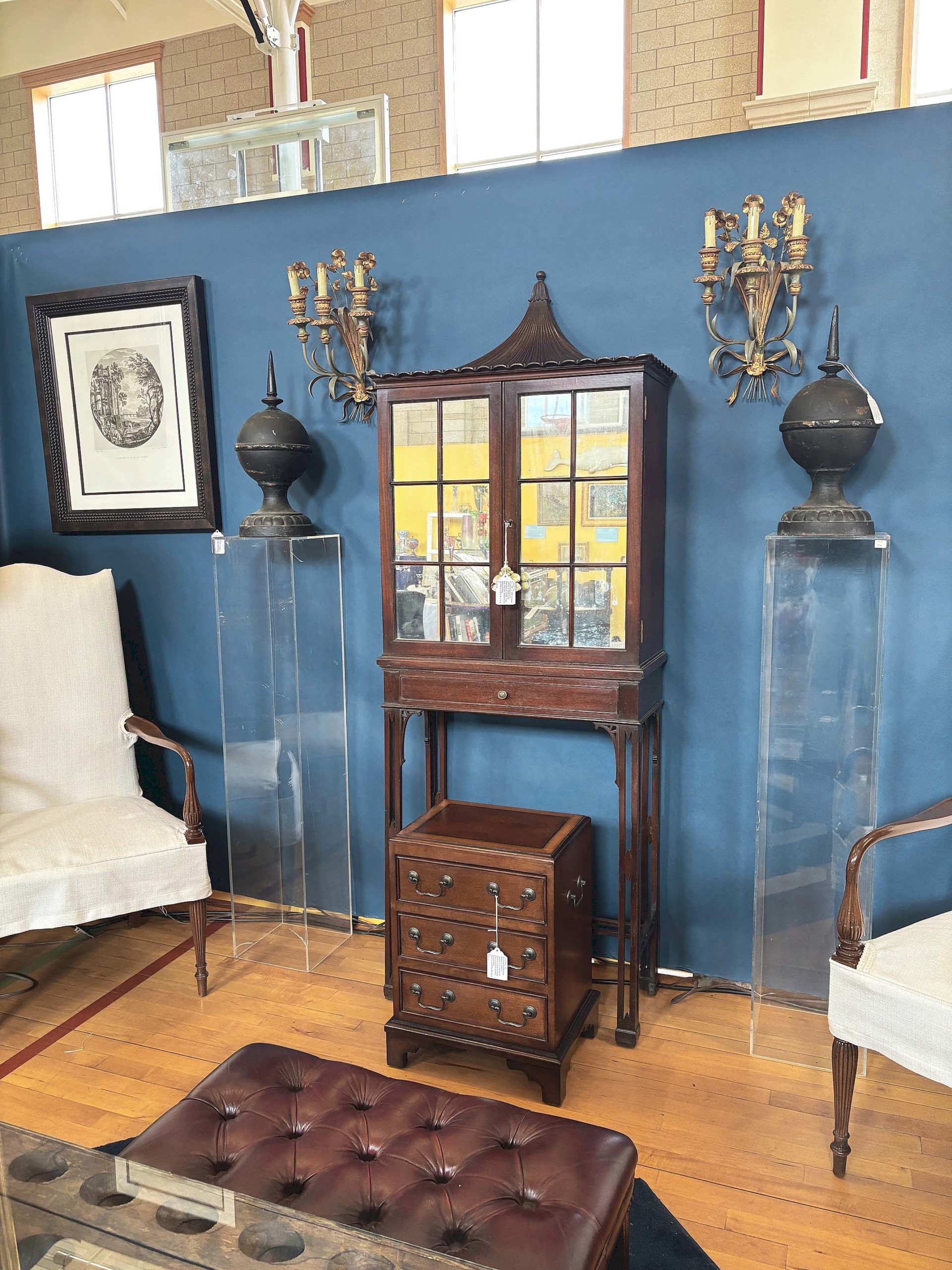
The mahogany Chinese pagoda-style cabinet was priced at $2,200 by Knollwood Antiques, Lee, Mass.
The offerings of Knollwood Antiques, Lee, Mass., included a circa 1890-1900 mahogany Chinese pagoda-form cabinet, which they priced at $2,200. They also had a miniature mahogany chest. It was probably English, stood 17 inches tall and had satinwood banding. On a bracket base, the price was $395. The day after the show, Richard LaVigne said “we sold 70 percent of what we brought.”
The Captain’s Quarters, Amherst, Mass., filled a booth with nautical items, including a portrait of the three-masted schooner Lena Nelson based in Searsport, Maine, that had been painted by Solon F.M. Badger (1875-1919) and showed the Boon Island lighthouse in the background. The painting, with its launch flag, was priced $11,195. Among its other offerings was a large hand-built, plank sailing ship model which was priced $795. A selection of carved coconut-shell dippers ranged in price from $250 to $550. They were among the dealers who said they a good day on the show’s opening day.
Dennis Raleigh and Phyliss Sommer, Searsport, Maine, had one of the largest oval covered boxes you’re likely to find. It measured more than 26 inches wide, had a red surface and had been assembled with hand-made nails; it was tagged $1,150. An exceptional double sailor’s valentine was $1,850. They were asking the same price for a large, folky heron or egret decoy with an old surface.
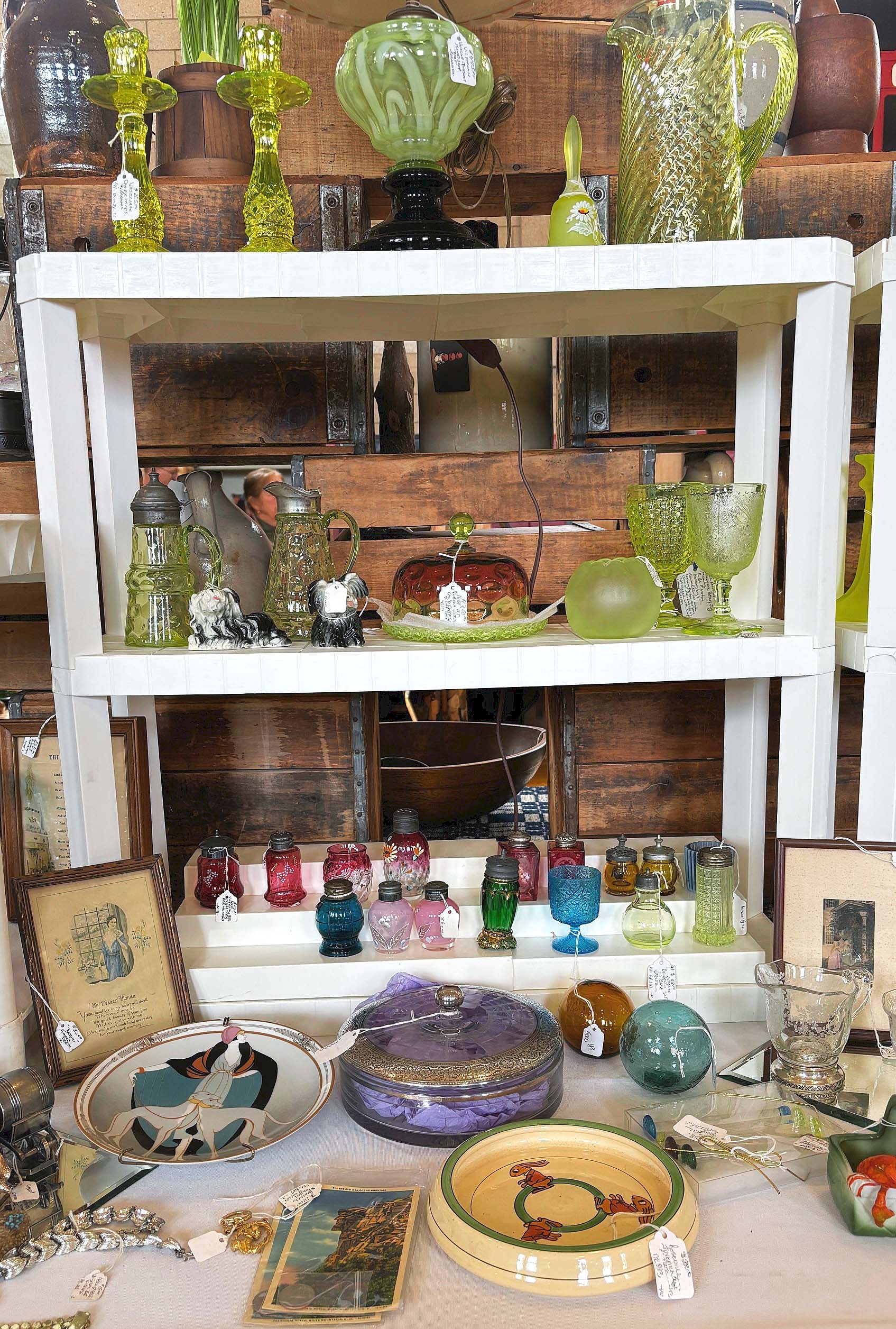
Lovers of Victorian-era colored glass enjoyed the full booth of C&J Antiques, which had Vaseline, cranberry, rubina verde and more. Norfolk, Mass.
For the colored glass enthusiast, C&J Antiques brought a number of pieces, including an inverted hobnail rubina verde covered cheese dish for which they were asking $350. This type of glass was made by the J.J. Hobbs, Brockunier & Co. Rubina verde was the name the manufacturer used for red and green glass, which was made in many forms around 1890. The selection the Norfolk, Mass., dealers brought also included silverplated napkin rings and Vaseline glass in several forms as well as an assortment of cranberry glass.
Painted porcelain is a specialty of Dark Flowers Antiques; the Fall River dealer had a wide selection of iridescent Zsolnay porcelain, which was made in Hungary beginning around 1853. According to a label accompanying the selection, the iridescent Eosin glaze is the result of multiple coatings of different glazes, which mellows over time and as a result of exposure to the air. More than a dozen pieces were on offer, including a large grouping with cats and kittens, circa 1920-40, for which they were asking $225. A long-haired dachshund, which could have been made any time between the 1920s and 1960s was priced $125. A lobster or crayfish and snake design tray, made between 1920 and 1940, was $245.
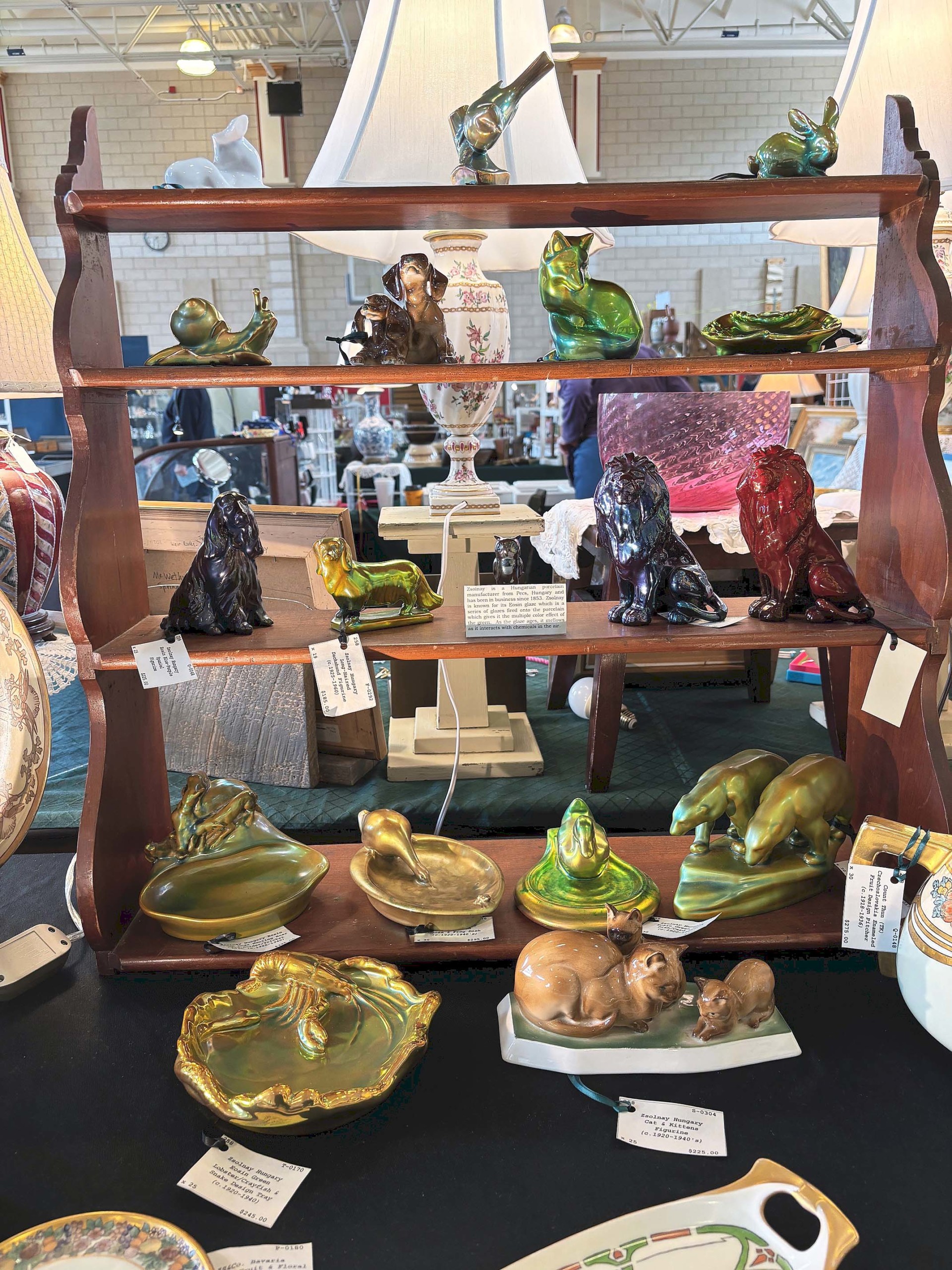
There were several pieces of Hungarian-made Zsolnay porcelain in the booth of Dark Flowers Antiques, Fall River, Mass. Most were priced less than $250.
Brad Finch, Spyglass Antiques, Cape Cod, Mass., had an 1832 colored engraving of a scene from the Revolutionary War battle of Lexington. Originally engraved by Amos Doolittle, the copy Finch had was reengraved by Joel Barber and published in 1831 in History and Antiquities of New Haven. Doolittle was at the battleground, arriving about 10 days later with his friend, the painter Ralph Earl. Doolittle interviewed eyewitnesses and produced a set of four engravings of the battles of Lexington and Concord, which are considered quite rare. Historians consider them to be very accurate renditions of the events of April 19-20, 1775. Finch was asking $725 for his copy.
After the show, John DeSimone said, “I wish we could have shows like this every week. Just about every dealer said they did well and so much furniture and other stuff went out on Saturday. We sold a large, English circa 1790 chest-on-chest, a green cupboard, and after the show we got a call from a customer who had been at the show and decided he wanted to buy a very nice tiger maple slant front desk that we had. The crowd was exceptional both days; it was just one of those times when everything worked.”
For information, 800-641-6908 or www.goosefareantiques.com.

